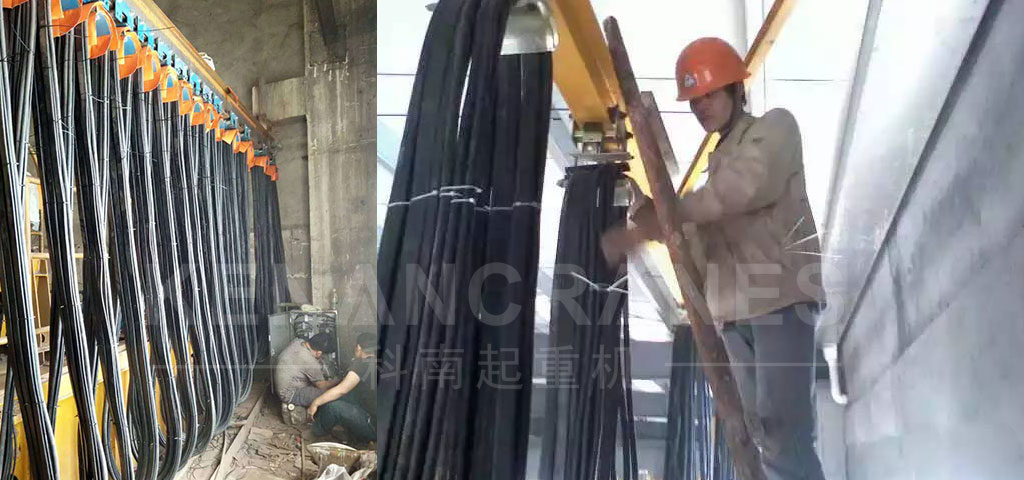WhatsApp: +8619037303917
Email: [email protected]
WhatsApp: +8619037303917
Email: [email protected]

Overhead cranes are essential for lifting and moving heavy loads in various industries, but they can also be dangerous if not properly maintained. One crucial component to inspect regularly is the crane cable. In this article, we'll walk you through how to inspect overhead crane cable to ensure it's safe to use.
Step 1: Visual Inspection
A visual inspection is the first and most crucial step in inspecting overhead crane cable. Start by visually inspecting the entire length of the cable for any visible damage such as kinks, twists, or broken wires. It's essential to look closely at areas where the cable is bent or wrapped around a sheave or drum as these areas are more prone to damage.
You should also inspect the cable for any corrosion, rust, or other forms of damage. Corrosion can weaken the cable and eventually lead to cable failure. Rust can also cause the cable to weaken and become more susceptible to damage.
If you find any visible damage during the visual inspection, you should immediately stop using the cable and contact a qualified technician to repair or replace the cable.
Step 2: Tension Inspection
The tension of the crane cable is another critical factor to inspect. The tension of the cable affects the crane's lifting capacity and overall safety. To test the tension of the cable, use a tension meter to measure the amount of tension in the cable.
If the tension is below the recommended level, the cable may need to be adjusted or replaced. A cable with insufficient tension can cause the crane to tip over or drop the load, which can result in serious injury or damage to property.
The tension level below the recommended level for overhead crane cable can vary depending on the manufacturer and type of crane. It's essential to refer to the manufacturer's guidelines and specifications for the specific crane and cable in question to determine the recommended tension level.
Typically, the recommended tension level for overhead crane cable is between 1% to 5% of the cable's breaking strength. If the tension level falls below this range, it can indicate that the cable is worn, damaged, or has lost some of its strength. In this case, the cable may need to be adjusted or replaced to ensure the safety and reliability of the crane.
It's important to note that incorrect tension can have serious consequences, such as the crane tipping over or dropping the load. Therefore, it's crucial to inspect the tension of the crane cable regularly and ensure that it falls within the recommended range.
Step 3: Lubrication Inspection
Proper lubrication is critical for preventing wear and tear on the crane cable. Without proper lubrication, the cable can become worn and damaged, leading to cable failure. During the inspection, check the cable for any signs of insufficient lubrication, such as rust or corrosion.
If you find any signs of insufficient lubrication, apply a suitable lubricant to the cable. Be sure to follow the manufacturer's recommendations for the type of lubricant to use.
Step 4: Non-Destructive Testing
Non-destructive testing (NDT) is the final step in inspecting overhead crane cable. NDT is a way to detect any internal defects that may not be visible during a visual inspection. There are several methods of non-destructive testing, including magnetic particle inspection, ultrasonic testing, and eddy current testing.
Magnetic particle inspection is a process that involves magnetizing the cable and then applying a solution of iron oxide particles to the surface. The particles will collect at any defects, allowing them to be easily seen.
Ultrasonic testing is a process that uses high-frequency sound waves to detect internal defects in the cable. The sound waves will bounce off the defects and return to a receiver, where they are analyzed.
Eddy current testing is a process that uses an electromagnetic field to detect defects in the cable. The test works by inducing a current in the cable and then measuring the resulting magnetic field.
NDT is an essential part of the inspection process and should be performed by qualified technicians. If any internal defects are found during the inspection, the cable may need to be repaired or replaced.
In conclusion, inspecting overhead crane cable is critical to ensure the safety and reliability of the crane. By following these steps, you can identify any issues with the cable before they become serious problems. Remember, if you find any visible damage during the inspection, stop using the cable immediately and contact a qualified technician to repair or replace the cable.
Kinocranes provides annual free maintenance services for our long-term cooperation customers in Pakistan, Bangladesh, and other regions. Our team of qualified technicians can provide professional cable maintenance and replacement services upon request. If you require cable maintenance or replacement, please don't hesitate to contact us for assistance.
TO TOP